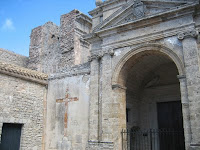Erice, Mountain of God
 Last October, I attended a scientific conference in Erice, a small medieval-era town perched atop a mountain on the western coast of Sicily. On my first walk around Erice I encountered two priests as they hurried along the town's cobble-stone streets. I vividly remember those two priests because they seemed to perfectly personify the place the locals call "Erice, Mountain of God."
Last October, I attended a scientific conference in Erice, a small medieval-era town perched atop a mountain on the western coast of Sicily. On my first walk around Erice I encountered two priests as they hurried along the town's cobble-stone streets. I vividly remember those two priests because they seemed to perfectly personify the place the locals call "Erice, Mountain of God."The narrow winding streets and crumbling buildings provided an interesting backdrop to our conference on the most modern of topics: how science might inform policy decisions on urgent and pressing issues such as climate change, financial market dynamics, the spread of epidemics, and on and on.
The first priest I encountered as I searched for the lecture hall emerged wearing robes and a large cross from a small Italian car, his robes flapping in the wind, the unmistakable sound of hip-hop music blaring from the radio. The second priest dashed out of a church and pulled a cellphone from somewhere inside his also-flapping robes that he proceeded to talk into in rapid-fire Italian. These two, the hip-hopping priest and his cellphone-connected colleague, seemed to hold within themselves the mix of ancient and modern, sacred and secular that I soon learned permeated all of Erice.
Our meetings were held in the P.A.M. Dirac auditorium located in the completely-refurbished interior of the San Domenico church, shown here. When looking for our meeting room, I walked by the building several times when I first arrived, not believing that this crumbling structure which was so obviously a church could hold an auditorium named after one of the most famous quantum theorists in scientific history.
But it did. And this church was not unusual. Other churches in this tiny pre-medieval town looked their age on the outside, but tucked away in their interiors were lecture halls, computer labs and gathering spaces for the hundreds of scientists who collect in Erice every week to discuss topics ranging from nuclear physics to molecular biology.
My room was in an old convent, with floor-to-ceiling doors that opened onto an interior courtyard. I learned, later, that I had been placed in the Abbess' room, although I am quite sure that my hosts, the Ettore Majorana Foundation and Centre for Scientific Culture, or EMFCSC, had no idea how appropriate this room assignment was! (See sidebar, if you don't know what I'm talking about...)
The EMFCSC are key participants in a major civic project called "Erice: Mountain of God," which seeks to renovate and restore the many churches and monasteries in Erice, some dating to pre-medieval times. For their part, the EMFCSC have built a modern scientific conference facility within the city's ancient churches and convents.
My room was in the San Francesco monastery and housed the Eugene Wigner Institute and the Enrico Fermi lecture hall. Posters on the walls of the three monasteries that contain the EMFCSC summarized its history. Founded in 1963 by a group of scientists concerned about the ethical and moral issues posed by the discovery and use of nuclear energy, the EMFCSC is open about its interest in issues at the boundary of science and faith. The following statement can be found on their website:
"To conduct Science means to discover the Fundamental Laws of Nature. The applications of great scientific discoveries almost always slip out of the control of Science itself. This is why technological development almost always contradicts the values instilled by Science: love for Creation and respect for life and human dignity. “Science and Faith are both gifts of God”, said John Paul II. No Pope has ever before had the courage to put Science and Faith on pedestals of equivalent dignity, and it is out of this truth that the new role of Science is born."
The documents go on to claim a central role by the Center's president, Antonino Zichichi, in bring the Catholic Church and the Pope to a place where they did an about-face on the case of Galileo Galilei after more than 400 years. Zichichi is a somewhat controversial figure and it is still not entirely clear what role he actually played in Galileo's rehabilitation by the Church.
Our meeting in Erice was held in early October, 2008 as the financial markets of the world crashed and tumbled all around us. It was both fitting and ironic, as I was soon to find, that this calamity happened at the same time as our conference.
But that part of the story will have to wait for a later time, as this blog post is already getting to be too long. More next week about my visit to Erice, Mountain of God.
This comment has been removed by a blog administrator.
ReplyDelete